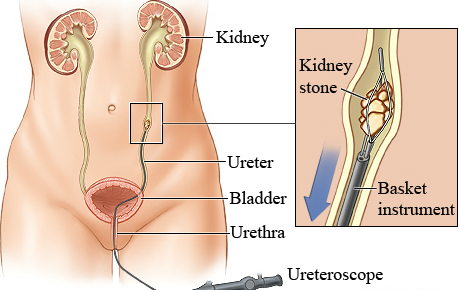Ureteroscopy can treat stones which are placed at some position in the ureter and kidney. In addition to this, ureteroscopy may allow the treatment of stones that cannot be visualized under an x-ray. Some patient’s who are not able to treat with ESWL or PERC, like those who not safely stop taking blood thinners, morbidly obese and women who are pregnant can also be treated by ureteroscopy.

PROCEDURE:
For this method the surgeon, won’t make any incisions or cuts. He or she initially inserts a thin viewing instrument (ureteroscope) into the urethra (the tube that leads from the outside of the body to the bladder). Then the surgeon passes the ureteroscope through the ureter and bladder, to get where the kidney stone is located exactly.
-
The urologist will remove the kidney stone with the help of an instrument with a “basket” that will grab the stone or with the help of forceps.
-
Smaller stones can be discarded all in one piece. But whereas for larger stones they may need to be broke up before they need to be removed.
-
Many types of instruments are in accessible to break up stones. But most urologists will prefer to use a laser.
-
For certain hours after the method you may have a burning feeling when you pass urine. This feeling will go away within a day. Consuming lot of water may help to reduce the burning feeling. Your doctor may also suggest you to take medicine to relive the burning.
-
You may observe some blood in the urine for 2 or 3 days.
-
The urologist may also use the ureteroscope to contact a kidney stone has been stuck in the ureter just after it leaves the kidney. Doctor may then try to push the stone back into the kidney. After the stone is back to the kidney, with the help of lithotripsy the stone may be broken.

